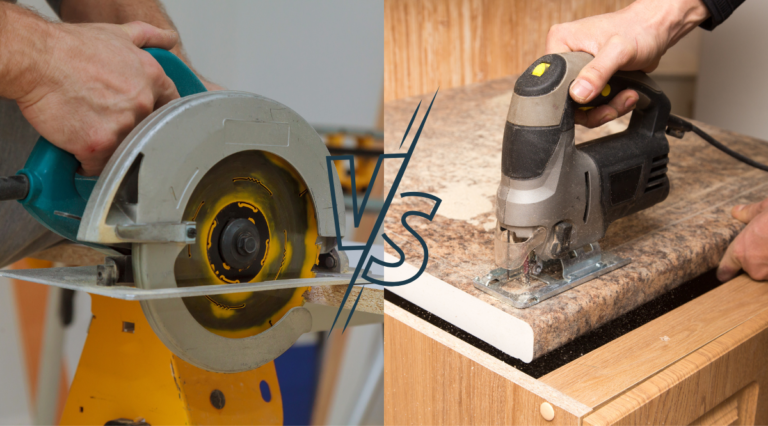Jigsaw vs Router – Which one should I choose?
As an Amazon Associate I earn from qualifying purchases.
A jigsaw and a router are both handheld woodworking tools, but the main dissimilarities we see are in their different working purpose, cutting capabilities, and features.
A router is not mainly a saw; you can round off exterior and interior edges and create grooves and hollows on it. However, with a jigsaw, you can do curve cuts and make shapes better, as its blades are small and narrow.
As a beginner, it’s hard to identify which one is needed in which context. So let’s elaborately compare and give you a clear idea between Jigsaw vs Router so that you can choose one according to their type of work.
Contents
Comparison Table Between Jigsaw vs Router
| Features | Jigsaw | Router |
| Blade | long serrated | Round bits |
| Main purpose | Cutting and shaping | Trimming and shaping |
| Power supply | Corded and cordless | Corded and cordless |
| Cut quality | Rough | Smooth |
| Inside cut | Yes | Yes |
| Curve cut | Better | Better |
| Straight cut | Better | Average |
| Deep cut | Deeper | Less deep |
| Round edges | No | Yes |
| Changing blades | Easy | Tough |
| Safety | Good | Less |
| Maintenance | Easy | Easy |
| Portable | Yes | Yes |
Pros and Cons Between Router and Jigsaw
Jigsaw
A jigsaw or a saber saw is a handheld power tool. They use thin blades that are mounted on the front of the upper body to provide carve cuts, angle lines, straight lines, and complex shapes on thin materials.
Also, you can cut the inside of the material without affecting the outside edge. This handsaw comes in corded or cordless versions to give you the advantage of taking them easily on working sites.
Router
A router is a handheld power tool that uses bits mounted middle down the body to create hollows and grooves inside a block of wood and round inside and outside edges. Though a wood router is not mainly a saw, it can make cuts and curves in thin wood but not deep and accurate like a jigsaw.
They come in corded or cordless electric versions to give you the freedom to take them anywhere. Also, you get the manual router; they do not have motors.
Differences between Jigsaw and Router
The similarities and dissimilarities shown here will help you understand when and for which project you should use a jigsaw and a router.
Blades
A jigsaw uses long, serrated reciprocating blades that do up and down movements to cut and pull the chips out. Whereas a router uses bits instead of blades, bits are really sharp that rotate fast to trim the wood.
Changing Blades and Bits
Changing blades on a jigsaw is way easier than changing bits on a router. To change a bit on the wood router, you need a wrench to lock the blade and loosen it, and after installing a new bit, you have to adjust the depth.
While changing the blade on a jigsaw, you have to rotate or spin the spring-loaded clamp or unscrew it, and after installing a new blade, you just have to free the spring-loaded clamp or tighten the screw.
Cutting
Though a router is not mainly a saw, it can cut really thin wood. But it won’t cut like a jigsaw. Instead of it, a wood-router round inside and outside edges and creates grooves, circles, hollows, slots, shapes, joints, and more.
Another hand, a jigsaw can make curves, straight lines, angle lines, shapes, and cut on the inside of a material without affecting the outside edge.
But a wood router makes more smooth cuts than a jigsaw as they use rounded bits. So after using a router on wood, you barely need to do sanding to smooth it.
Depth of cut
As a jigsaw uses a long-serrated blade for that, it can cut deep curves, straight lines, and angle lines. On the other hand, a router uses a bit that is designed to cut grooves and hollows into the wood but can’t make depth cut like a jigsaw.
Versatility
The wood router and jigsaw are versatile as they are both portable and easily moveable on wood and other materials and can be used for large and small sizes of wood.
But with a jigsaw, you can do freehand straight-line cuts without having any guidelines. Whereas with a router, you need some guidelines as the bit gets covered down the router.
Accuracy
A portable jigsaw maintains more accuracy in cutting than a router. A portable router uses rounded bits that rotate faster than the jigsaw blade; for that, it’s hard to make a straight line even if you have a guide.
Note: A router needs a physical guide to have accuracy.
In a jigsaw, you don’t need any setup; you can make or have a straight line cut with or without a guide.
Note: if you use a router table, then you get more versatility and accuracy than a jigsaw.
Cutting Material
A jigsaw can be used on more materials than a router. For example, a jigsaw can be used for cutting wood, particleboard, metal, plastic, tile, carpet, and plywood. In comparison, the router can be used only for wood and plastic.
Weight and size
Rounded and jigsaw power tools are both weightless and come in small sizes to operate easily with one hand. But sometimes, you need to use both hands to operate a wood router.
Table
Nowadays, some routers include their own worktables where you can attach your router to make it like a table saw to have more accuracy and versatility while cutting. Here you get the features like guides, fences, and more.
Whereas a jigsaw does not come with anything like this.
Safety
A router is way more dangerous than a jigsaw; even a jigsaw has a blade, and the router has bits. In addition, a jigsaw runs at a lower speed than a router and is easier to operate and handle than the router.
As a router bit rotates at a really fast speed, it slips more and could crack wood which can also suffer you much.
Price
Both jigsaw and router are affordable. Spending around $50 to $200, you will get a quality jigsaw and router.
Which One Should I Choose; Jigsaw or Router?
There shouldn’t be any confusion on which one to choose in which context, as both are used for different working purposes, cutting capabilities, and features.
As for my usage, a jigsaw is more versatile and accurate on a variety of materials to have straight, curved, angle, shape, and inside cuts without affecting the outside edge. So, if you want a versatile and accurate saw on a variety of materials, you can go for a jigsaw.
Whereas the router is mainly for creating grooves, hollows, circles, shapes, joints, and rounding inside and outside edges. If you don’t need a cutting tool but instead need one that does these things, you can go for the router.
Also, I suggest you have both, where starting with a jigsaw, you can have a circular cut and finish with a router to have a delicate look.
Frequently Asked Questions
Can you use a router like a jigsaw?
You can use a router like a jigsaw to cut wood, but it won’t get the effect and accurate cut like a jigsaw. As the router’s rounded small bits are used for making patterns and shapes, it can be used for cutting thin wood but can’t cut thick wood like the jigsaw.
Can you freehand with a router?
Yes, you can freehand with a router. First, you must make a line or pattern with a pen where you want to trim. Then place the router there and put both hands on the router’s bottom so that the heels of your hand touch the board.
Then slowly and carefully tracks the line. Also, you can use a shield to freehand with a router. But to do this, you have to practice a little.
Should I push or pull a router?
It’s better to push a router than pull because it is safer. To have a push cut, you have to take the router and move the router on the outside counterclockwise around the board. It’s an easy trick and safer than pull.
Conclusion
The router and jigsaw are different structured tools, and their cutting and working purposes are also different. Nevertheless, I have described all their capabilities, working perspectives, and usage.
Both are good and useful in their specific cutting capabilities. Now you have to select one that goes according to your project to have a better result. Thank you.





